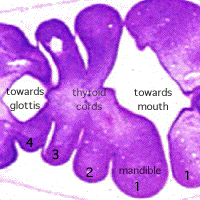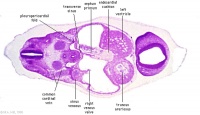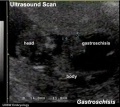BGDB Gastrointestinal - Early Embryo
| Practical 1: Trilaminar Embryo | Early Embryo | Late Embryo | Fetal | Postnatal | Abnormalities | Lecture | Quiz |
We have now reached the end of Week 4 and beginning of 5 of development. Start by looking briefly at the overview of the Carnegie stage 13 embryo GIT from one end to the other.
Then work through the listed specific serial sections of the embryo identifying the GIT features. Alternatively step through the serial sections yourself identifying the tract, its associated mesentries, organs and spaces.
Tract Development
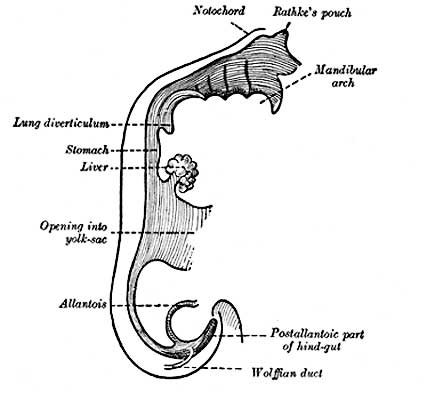
|
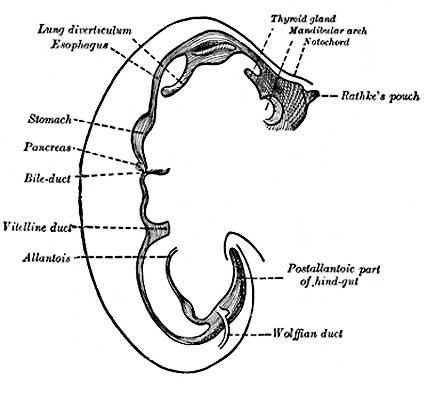
|
| Early Embryo | Later Embryo |
Carnegie Stage 13 (Week 4-5)
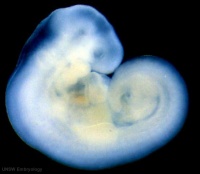
|
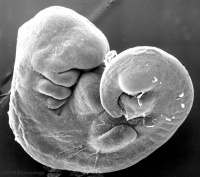
| |
| The individual serial slices have also been incorporated into a 3D model of this embryo. |
| Section | Name | Description |
|---|---|---|
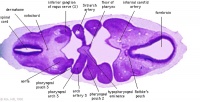
|
B1L | Pharynx
The righthand side towards the buccopharyngeal membrane, the lefthand side descending into the embryo body. Central region is the floor of pharynx formed by fusion of 3rd pharyngeal arches = hypopharyngeal eminence (precursor of root of tongue). Rathke's pouch forming the rudimentary adenohypophysis (anterior pituitary). |
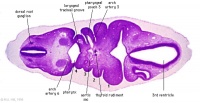
|
B3L | Laryngeal tracheal groove - beginning of ventral compression, at 90 degrees to the lateral plane of the pharynx above this point.
Rudimentary thyroid ventral to aortic sac (also seen in B2, ventral to the hypopharyngeal eminence). |

|
B4L | Laryngeal tracheal groove - Caudal pharynx compressed dorsoventrally.
Note that it lies between the aortic sac (ventrally) directly above the heart and the paired vessels of arch artery 6 and the dorsal aortas. The pale staining region behind these blood vessels is where the vertebral column will form. |
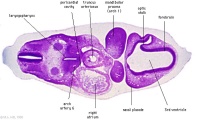
|
B5L | Laryngopharynx - now compressed dorsoventrally between the paired arch artery 6 vessels. |

|
B7L | Glottis - initial separation of the oesophagus (dorsal) from the trachea (ventral).
Note that this is occurring at the level of the heart atria. Nasal placodes. Pulmonary arteries. |
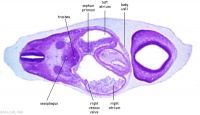
|
C1L | Gastrointestinal tract oesophagus (dorsal) is now separate from the respiratory trachea (ventral). |

|
C2L | Oesophagus and trachea both surrounded by dense mesenchyme.
Right nasal pit. |
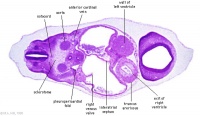
|
C3L | Oesophagus and trachea both surrounded by dense mesenchyme.
Common cardinal vein in the posterior wall of the intraembryonic coelom. The pleuropericardial folds which contribute later to the formation of the pleura and pericardium. In C4, junction of right common cardinal vein with dorsal wall of sinus venosus. Left nasal pit. |
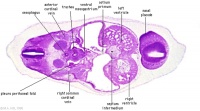
|
C5L | Smaller oesophagus and expanding trachea, this is also the upper region of the lung buds.
The ventral anchoring of attachment site is at the most cranial extension of the septum transversum. This attachment now divides the intraembryonic coelom around the trachea into two canals, the left and right pleuro (pericardio-peritoneal) canals. Canals are lined by coelomic mesothelium and are continuous with whole intraembryonic coelom (they will be referred to hereafter simply as coelomic canals). The pleuroperitoneal fold on the medial side of the right common cardinal vein will form part of the diaphragm. |

|
C6L | Trachea expanded and beginning to bifurcate to the major bronchial branches for each lung.
Lateral extension of pulmonary mesenchyme is moulded to shape of coelomic canals. Oesophagus lumen obliterated (common site of oesophageal atresia and/or tracheo-oesophageal fistula). Prominent R pleuroperitoneal fold. |
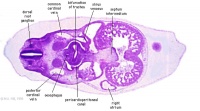
|
C7L | Trachea bifurcated to the major bronchial branches for each lung.
Note dorsal extent of coelomic canals. Oesophagus lumen reappears caudal to bifurcation. Distinct R (smaller on L) pleuroperitoneal fold below the common cardinal vein. |

|
D1L | Oesophagus/stomach junction.
Right lung bud bronchus still visible, left bronchus ends above this section. Note the oesophagus now lies in the midline between the 2 bronchi. Coelomic canals. |
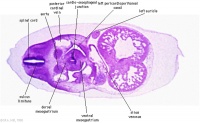
|
D2L | Ovoid stomach with developing space of the lesser sac on R.
Dorsal and ventral attachments of the mesenchyme are now known as dorsal and ventral mesogastria. Coelomic canals. |
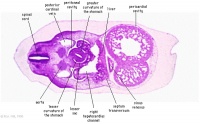
|
D3L | Rotation of stomach (seen from above) to right side.
Note change in outline of coelomic canals due to presence of liver. Lesser sac. Note thick mesothelium lining the coelom along left edge of stomach, the primordium of the spleen and greater omentum along greater curvature. Liver embedded in septum transversum (ventral border of septum transversum contributes to diaphragm). |
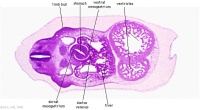
|
D4L | Rotation of stomach (seen from above) to right side.
Ventral mesogastrium - Stomach is attached ventrally to the liver. (note the position of the ductus venosus) Dorsal mesogastrium - within this structure the spleen will begin to form and later the greater omentum. Peritoneal spaces - identify greater and lesser sac. |
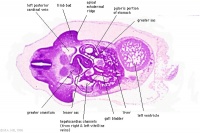
|
D6L | Pyloric region of stomach.
Ventral mesogastrium - Stomach is closely attached ventrally to the liver. Dorsal mesogastrium - within this structure the spleen will begin to form and later the greater omentum. Peritoneal spaces - identify greater and lesser sac. |

|
E4L | Midgut.
Region close to the umbilicus. Note the close associated portal vein and the paired placental (umbilical) veins. |

|
F1L | Midgut.
Looping out of body wall ventrally (cut tangentially). Also note the righthand side hindgut region. |
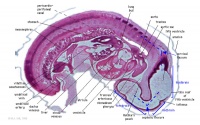
|
G7L | Caudal pharynx (extending laterally, ventral to dorsal aorta - cf B4). Stomach, mesentery |
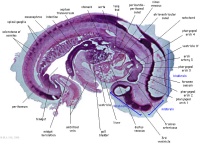
|
G6L | Narrow oesophagus. Tracheal bifurcation dorsal to sinus venosus. |
Peritoneal Cavity
- Fusion of the two separate intra-embryonic coelom spaces.
- Intestinal loss of ventral attachment, except at the level of the stomach, dorsal attachment becomes true mesentery.
Stomach Development
The stomach initially appears at this stage (5 weeks) as a dilatation of the GIT in the foregut, which over the next 2 weeks will continue to expand to a fusiform structure and differential growth will it rotate in both the longitudinal and the horizontal planes.
| <html5media height="520" width="490">File:Stomach rotation 01.mp4</html5media> |
Differential growth of the ventral and dorsal stomach walls leads to establishing a lesser and greater curvature. Key:
|
| Page | Play |
Lesser Sac Development
| Development of Lesser Sac | Development of Greater Omentum |
| Page | Play | Page | Play |
Key: Yellow - endoderm of stomach. Orange - liver developing in ventral mesogastrium. Red - spleen developing in dorsal mesogastrium.
Note the narrow tubular connection between the intestinal loop and the yolk sac.
| Gastrointestinal Tract Movies | |||||||||||||||||||
|---|---|---|---|---|---|---|---|---|---|---|---|---|---|---|---|---|---|---|---|
|
|
|
|
| |||||||||||||||
|
|
|
|
| |||||||||||||||
|
|
|
|
| |||||||||||||||
| Stage 13 (week 5) | Stage 22 (week 8) | Stage 23 (week 8) | GIT Abnormalities Ultrasound | ||||||||||||||||
| Practical 1: Trilaminar Embryo | Early Embryo | Late Embryo | Fetal | Postnatal | Abnormalities | Lecture | Quiz |
Related Terms
- coelom - (Greek, koilma = cavity) Term used to describe a fluid-filled cavity or space. Placental vertebrate development have both extraembryonic (outside the embryo) and intraembryonic (inside the embryo) coeloms. The extraembryonic coeloms include the yolk sac, amniotic cavity and the chorionic cavity. The initial single intraembryonic coelom located in the lateral plate mesoderm will form the 3 major body cavities: pleural, pericardial and peritoneal.
- greater omentum - A peritoneal fold of splanchnic mesoderm extending from the greater curvature of the stomach and hanging ventrally down "like an apron" in the peritoneal cavity over the small intestine. It forms initially in the embryo and fetus as a loop of the dorsal mesentery, which later fuses to form a single sheet attached to the posterior body wall. The lesser omentum is a smaller ventral peritoneal fold extending from lesser curvature of the stomach to liver.
- lesser omentum - The smaller peritoneal fold of splanchnic mesoderm extending from lesser curvature of the stomach to liver formed from the ventral mesentery at this level of the gastrointestinal tract. The second larger greater omentum extends from the greater curvature of the stomach and hanging down "like an apron" ventrally over the small intestine.
- lesser sac - (bursa omentalis, omental bursa) opening into the space behind the stomach and on the side of the lesser curvature.
| Gastrointestinal Tract Terms | ||
|---|---|---|
| ||
|
Additional Information
| Additional Information - Content shown under this heading is not part of the material covered in this class. It is provided for those students who would like to know about some concepts or current research in topics related to the current class page. |
Stage 11 to 13
Human embryos digestive tract was initially formed by a narrowing of the yolk sac, and then several derived primordia such as the pharynx, lung, stomach, liver, and dorsal pancreas primordia differentiated during Carnegie stage 12 (21-29 somites) and Carnegie stage 13 (≥ 30 somites).[1]
- ≥ 27 somites - liver bud seen
- Carnegie stage 13 - dorsal pancreas appeared as definitive buddings
- ≥ 33 somites around dorsal pancreas buddings the small intestine bent
- ≥ 34 somites - stomach is spindle-shaped
- ≥ 35 somites - small intestine rotated around the cranial-caudal axis, begun to form a primitive intestinal loop, which led to umbilical herniation.
Stomach curvature
Recent animal model studies suggest that the main driver of formation of stomach curvature is more about asymmetric growth of the left and right walls of the tube rather than the model of two 90 degree rotations.
- Stomach curvature is generated by left-right asymmetric gut morphogenesis[2] "Left-right (LR) asymmetry is a fundamental feature of internal anatomy, yet the emergence of morphological asymmetry remains one of the least understood phases of organogenesis. Asymmetric rotation of the intestine is directed by forces outside the gut, but the morphogenetic events that generate anatomical asymmetry in other regions of the digestive tract remain unknown. Here, we show in mouse and Xenopus that the mechanisms that drive the curvature of the stomach are intrinsic to the gut tube itself. The left wall of the primitive stomach expands more than the right wall, as the left epithelium becomes more polarized and undergoes radial rearrangement. These asymmetries exist across several species, and are dependent on LR patterning genes, including Foxj1, Nodal and Pitx2 Our findings have implications for how LR patterning manifests distinct types of morphological asymmetries in different contexts."
References
| Practical 1: Trilaminar Embryo | Early Embryo | Late Embryo | Fetal | Postnatal | Abnormalities | Lecture | Quiz |
BGDB: Lecture - Gastrointestinal System | Practical - Gastrointestinal System | Lecture - Face and Ear | Practical - Face and Ear | Lecture - Endocrine | Lecture - Sexual Differentiation | Practical - Sexual Differentiation | Tutorial
Glossary Links
- Glossary: A | B | C | D | E | F | G | H | I | J | K | L | M | N | O | P | Q | R | S | T | U | V | W | X | Y | Z | Numbers | Symbols | Term Link
Cite this page: Hill, M.A. (2024, April 28) Embryology BGDB Gastrointestinal - Early Embryo. Retrieved from https://embryology.med.unsw.edu.au/embryology/index.php/BGDB_Gastrointestinal_-_Early_Embryo
- © Dr Mark Hill 2024, UNSW Embryology ISBN: 978 0 7334 2609 4 - UNSW CRICOS Provider Code No. 00098G


